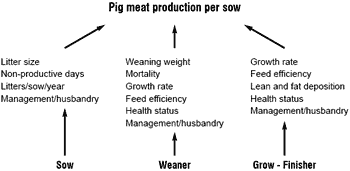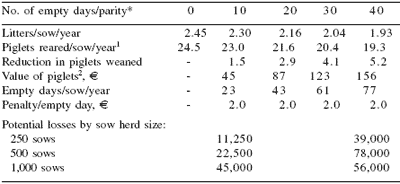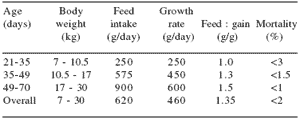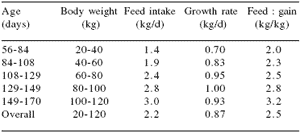Creating technical and educational forums that help pig producers meet performance and economic goals: the Premier Pig Program™
Regardless of where pigs are produced the objectives should be the same: to optimise the quantity of pig meat produced per sow per year or per lifetime, at minimal cost. For the modern sow and pig genotypes, with pigs being sold at 100 kg liveweight, the objective should be to produce at least 1 tonne of carcass lean per sow per year. This is achieved as in Table 1.
Table 1. Targets for producing 1 tonne of carcass lean per sow per year with pigs sold at 100 kg liveweight.
If pigs are sold at 120 kg body weight, then the target should be 1.25 tonne of carcass lean per sow per year, or 2.50 tonne carcass lean per lifetime. The performance of the animal at all stages of production, that is the sow, weaner and grow-finish pig, contribute to these target levels of performance, as indicated in Figure 1.
Figure 1. Primary factors affecting pig performance.
Indeed, it is important to establish target levels of performance for each stage of production, so that producers can benchmark the performance on their own farm relative to industry standards. Suggested indices for the breeding, weaner and grow-finish animal are listed in Table 2.
If performance is below expectation, then it is important to identify those factors that limit performance and to take appropriate actions to avoid loss of productivity. This is the aim of the Premier Pig Program™.
Objectives of the Premier Pig Program™
The Premier Pig Program™ has been developed to provide independent technical information and support appropriate to all sectors of the pig industry worldwide. Although many factors influence financial performance, the key factor influencing the efficiency and cost of production is nutrition, with the cost of feed representing 60-70% of total production costs in many countries. Understanding the nutritional needs of the pig at all stages of growth and providing the correct diets and nutritional management is fundamental to efficient and profitable production.
The major objectives of the Premier Pig Program™ are therefore:
• To provide user-friendly technical information and support to all sectors of the industry
• To suggest target objectives for modern pig production
• To compare actual and target levels of productivity and identify areas of concern
• To propose actions and solutions that can be taken on-farm to enhance performance
• To provide technology to allow long-term sustainable production
• To help in the application of new concepts and technologies
A major feature of the program has been the publication of a manual, which details the appropriate nutrition and management of the pig at all stages of production. Information is provided on nutritional needs and on those factors that influence them. Differences in genetic potential, health status, housing and environmental conditions all influence animal performance and these must be considered, as well as the requirements of the market. Fortunately, our knowledge of the biology and nutritional physiology of the pig has advanced sufficiently in recent years to allow these to be considered in the development of any feeding and management strategies to meet individual needs and animal circumstances.
The manual also suggests target levels of performance so that producers can benchmark their farm’s performance against industry standards. It discusses what intervention strategies and actions can be taken on-farm if performance falls below expectation. In this way both production and economic efficiency can be improved.
The Premier Pig Program™ and the manual cover the following areas:
• Nutrients in the diet
• The breeding pig: sow and boar
• The weaner piglet
• The grower/finisher pig
• Meat quality
• Environmental issues
Nutrients in the diet
The objective is to provide a reference base to explain the major roles of energy, protein, amino acids, minerals and vitamins for the normal functioning of the animal’s metabolism and for the maintenance of good levels of reproduction and growth, as well as its health and well being. Sources of nutrients are also discussed.
Table 2. Performance targets for sows, piglets and grow-finish pigs.
The breeding pig: sow and boar
The nutritional and management needs of the replacement gilt and the gestating and lactating sow are discussed, including those factors that influence them. This allows practical feeding and management strategies to be developed to optimise and to sustain long-term sow productivity.
Target levels of performance for the sow are suggested, as well as the threshold or intervention levels when action needs to be taken to avoid loss of productivity (Table 3). The nutritional, management and healthcare strategies needed to meet these target levels of productivity are discussed and the economic costs of lost productivity highlighted.
Table 3. Key factors influencing sow productivity.
* These are dependent on the age at weaning
A major factor limiting the number of piglets produced per sow per year is the number of litters per sow per year, which is a reflection of the number of empty or non-productive days. These are expensive in terms of lost productivity; and some idea of the economic loss for different sow herd sizes is provided in Table 4. Thus, another important objective of the Premier Pig Program™ is to provide procedures that allow calculation of the cost of lost productivity, such as that associated with the number of empty or nonproductive days.
The nutritional and management needs of the boar are different from those of the sow and these are discussed. Strategies need to be developed to optimise semen quality, since this influences fertilisation rate and hence, potential litter size. A summary of the major factors that influence sow reproductive performance are given in Table 5.
The weaner piglet
Weaning is a major challenge to the young piglet and represents a critical period in its life. In nature, weaning is a gradual process that is completed at some 10-12 weeks of age. In commercial practice, weaning normally takes place at between 14 and 28 days of age, or sometimes later, and is an abrupt process that has considerable consequences for the piglet, involving substantial changes in its metabolic, physiological, endocrine and immune processes and greatly affecting its subsequent growth and health status.
Table 4. Example calculation of the economic loss associated with empty or non-productive days.
*Assumes a parity of 149 days: 114 days gestation + 28 days lactation + 7 days wean-mating 1Assumes 10 piglets reared/litter
2Value of piglet = €30
+Values may change depending on country
Table 5. Suggested feeding and management strategies to optimize sow productivity.
| 1 Select gilts as early as possible; important for acclimatisation | |
| 2 Feed special gilt rearing diet: flush-feed before mating (high ovulation rate) | |
3 1st mating at: | 220 - 230 days of age 130 - 140 kg body weight 16 - 20 mm P2 (condition score: 3.0) 2nd or 3rd oestrus period |
| 4 Reduce feed intake in gilts for 3 weeks post-mating (high embryo survival) | |
| 5 Then feed to body condition: target condition score at farrowing 3.5 (scale 1-5) | |
| 6 If temperature <20°C, increase feed allowance by 4% per 1°C below 20°C | |
| 7 Increase feed intake over last 4 weeks of gestation to optimise birthweight and mammary development | |
| 8 Reduce feed 1-2 days before farrowing to facilitate farrowing process | |
| 9 After farrowing: gradually increase daily intake over first week; then feed to appetite | |
| 10 Good appetite during lactation is critical for high piglet weaning weight | |
| 11 Mean requirements during lactation 100 MJ DE (23 Mcal ME) and 60 g lysine/day | |
| 12 Minimise loss of body weight and condition. Target condition score at weaning 2.5 (scale 1-5) | |
13 Piglet weaning weight: 7 kg at 23 days. Each 1 kg litter growth rate requires 4 l of milk | |
14 Feed separate gestation and lactation diets:
| |
| 15 Lactating sows need 30-50 l water/day; nipple flow rate >2.0 l/min | |
| 16 Reduce demand on sow provide supplementary feeding to piglets, cross-foster or split-wean | |
| 17 Reduce empty or non-productive days: each day costs ~ 2.0 € | |
| 18 Organic minerals boost reproductive performance. Role of: Se, Cr, Fe and SowPakTM | |
| 19 Ensure good sow health and welfare. Role of Bio-Mos®; also good hygiene | |
| 20 Don’t forget the boar! Semen quality, high fertilisation rate, high litter size | |
The Premier Pig Program™ therefore discusses:
• The metabolic, endocrine and physiological changes that occur at weaning and how these may be manipulated for the benefit of the piglet
• Growth potential and target levels of performance
• How the nutritional needs can best be met and feed and water management
• Ways to enhance appetite post weaning
• Environmental and housing requirements
• How to ensure a high immune and health status
• The importance of good management, husbandry and healthcare practices.
If the effects at weaning are minimised, then it is possible to produce a 30 kg piglet at 10 weeks of age. The target levels of performance at the different stages post-weaning needed to achieve this are suggested in Table 6.
Table 6. Suggested target levels of performance for the piglet post-weaning.
The importance of weaning weight and performance in the post-weaning period, and their effects on subsequent growth rate and performance, are recognised and ways on how to achieve this are suggested in Table 7.
Table 7. Suggestions for achieving good piglet performance postweaning.
| 1 Maximise weaning weight: target 7 kg at 23 days (appropriate sow feeding) |
| 2 Provide supplementary feeding when sow milk supply is inadequate or litter size is >10 |
| 3 Pen according to weaning weight and size |
| 4 Special care for smallest piglets (or delay weaning) |
| 5 High feed intake post weaning is critical |
| 6 Growth rate must be at least 200 g/day to maintain body fat reserves |
| 7 Feeding high quality diets of correct nutrient specification is essential |
| 8 Phase diets to piglets needs and digestive competence |
| 9 Feed a little and often just after weaning, with sufficient trough space (50 mm/pig) |
| 10 Feeder hygiene is critical: clean at least twice per day immediately post-weaning |
| 11 Wet (gruel) feeding for first few days is beneficial |
| 12 Adequate number of drinkers (10 piglets per bowl): water flow rate 1.0 l/minute |
13 Temperature: initially 28°C; then reduce by 2°C each week until 20°C. If housed in shelters, provide ample straw bedding material and creep area |
| 14 Maintain good air quality: do not reduce ventilation to maintain temperature |
| 15 Avoid draughts and wet floors |
| 16 Do not overstock: each piglet needs 0.20 m2 in conventional housing, or 50% more if in alternative bedding systems |
| 17 Lighting: leaving lights on for the first few days may help |
| 18 Promote good health and immunity: treat sick animals promptly |
| 19 Good hygiene, cleanliness and disinfection between batches is essential |
| 20 There must be a high degree of stockmanship |
The grower/finisher pig
The modern pig has a high potential for growth and protein or lean gain. Indeed, growth rates in excess of 1.2 kg/day and protein gains greater than 200 g/ day have been achieved in the grow-finish period under ideal conditions. Although these rates are seldom achieved in practice, the potential for growth is higher than that currently achieved on many farms and target levels are suggested in Table 8. If these levels of growth are not achieved, then extra feed is required and the time taken to reach slaughter weight is increased. This increases the cost of production as shown in Table 9.Ways to achieve good performance are presented in the Premier Pig Program™. A summary of the major factors that influence the performance of the grower-finisher pig, and which are discussed in the Premier Pig Program™, is presented in Table 10.
Table 8. Suggested targets for the grower-finisher pig under good commercial conditions.*
*Assumes a good rate of protein or lean gain, with a P2 value of 10-12 at 100 kg body weight and 12-14 mm P2 at 120 kg body weight.
Meat quality
Factors influencing both carcass and meat quality are discussed, including the components of meat quality. The nutritional and managemental procedures that can be employed to ensure a more consistent product of good meat eating quality with desirable flavour and good keeping and hygiene quality are highlighted.
Environmental issues
Interest in the environment has intensified in recent years and there is much discussion on how to reduce environmental pollution from whatever source. With regard to pig production, the major concerns are the excretion of excessive nitrogen and phosphorus and the emission of noxious gases, such as NH3, CO, CO2 and H2S. Ways to minimise these pollutants are discussed.
Table 9. The predicted cost of reduced growth rate (20-100 kg body weight).
*Comparisons are made with a pig growing at 1000 g/day and having a mean feed intake of 2.3 kg/day
*Cost of feed € 200/ton. Each extra day costed at € 0.1/day
1Values may change depending on country
Table 10. Suggestions for optimizing performance of the grow-finish pig.
| Target | Suggestion for achieving target |
| 1 What is the growth rate of your pigs? | Monitor performance regularly |
| 2 Target growth rate (20-100 kg bodyweight) | 850 g/day and FCR of 2.5:1 |
| 3 Poor growth costs money. | Each 50 g/day reduction in growth (20-100 kg) costs € 2.0/pig |
| 4 Optimise lean tissue growth. | Higher growth rate, better FCR, reduced P2 = higher carcass value |
| 5 Phase feed according to the needs of the pig. | 120 kg: 14.5 MJ DE and 11.0 g Lys/kg (0.76 g/MJ) 2100 kg: 12.5 MJ DE and 7.0 g Lys/kg (0.55 g/MJ) |
| 6 Overall herd FCR target: 2.80 kg/kg live weight; 3.50 kg/kg carcass weight. | How do your values compare? |
| 7 Good quality diets are essential. | Minimal changes of ingredients and low antinutritional factors (ANFs) |
| 8 Avoid excessive feed wastage. | Wastage is expensive and should not be >5% |
| 9 Good bin hygiene is essential to reduce moulds and mycotoxins. | Consider mycotoxin adsorbents |
| 10 Wet feeding or wet and dry feeders | Better FCR values and growth rates than dry feeding |
| 11 Water is essential: Requirement is 0.1 l/kg body weight: 20 kg = 2 l/day; 100 kg = 10 l/day | Consumption is 2-3 times higher in hot conditions (30°C) |
| 12 Adequate number of drinkers | 10 pigs/drinker, water flow rate 1.5-2.0 l/min |
| 13 Environmental needs | Are pigs huddling? = too cold! Are they panting, dirty and lying dispersed throughout the pen? = too hot |
| 14 Do not overstock | Pigs need 0.3 (25 kg) to 0.7 (100 kg) m2/pig in conventional systems; and more in alternative systems |
| 1 5 Maintain good air quality and ventilation rate. | Avoid dust and noxious (smelly) gases |
| 1 6 Poor health is the greatest barrier to good growth: promote good health and immunity. | Reduce stress, treat sick animals promptly |
| 17 Good hygiene | Cleaning and disinfection between batches is essential. All-inall- out |
| 1 8 Do not stress animals when moving. | Good handling and transportation will enhance carcass and meat quality. |
| 1 9 High degree of stockmanship is required at all times. | Positive interaction with animals |
| 2 0 Staff morale and skills | Provide good facilities for staff and ensure proper staff training. |
2100 kg: 2.85 Mcal ME and 7.0 g Lys/kg (2.5 g/Mcal)
Application of the Premier Pig Program™
The program was launched in New Zealand and Australia during 2002 and 2003 as a series of three workshops dealing with the breeder, weaner and grower/finisher pig. Approximately 1,000 people attended these workshops, representing 90% of the Australian and New Zealand pig population. The positive response from and uptake by the industry was such that the program has now been launched in Asia and Europe with considerable success.
The Premier Pig Program™ has been designed to continuously evolve. As new research results and technical data become available, updates to the manual will be prepared and distributed. In this way, the manual will be kept up-to-date and relevant. The overall objective is to provide practical information in order to ensure long-term efficiency and profitability of pig production.
Acknowledgement
It is a pleasure to thank Dr. Bruce Mullan, Department of Agriculture, Western Australia, Mr. Tony Edwards, A.C.E. Livestock Consulting Pty. Australia and Dr. Kate Jacques, Alltech Inc. Lexington, KY, USA, for their contributions to the development and application of this program.
Authors: WILLIAM H. CLOSE1 and KIM TURNLEY2
1 Close Consultancy, Wokingham, Berkshire, UK
2 Alltech Inc., Melbourne, Victoria, Australia







